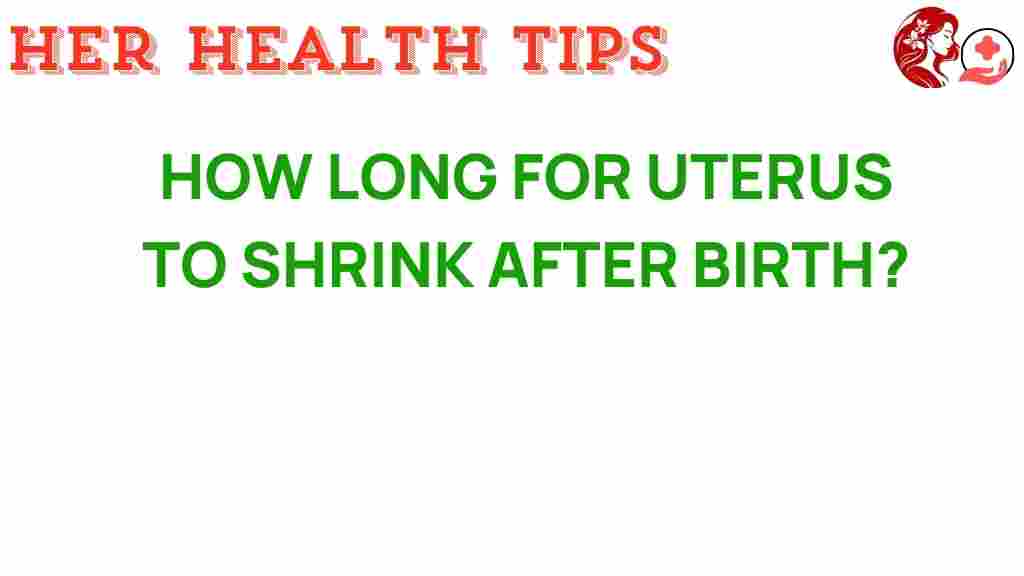The Fascinating Journey: How Long Does It Take for the Uterus to Shrink After Birth?
The journey of motherhood is a remarkable and transformative experience, not just for the baby but for the mother as well. One significant aspect of this journey is the postpartum recovery phase, particularly concerning the uterus. Understanding how long it takes for the uterus to shrink after birth is crucial for maternal health and overall well-being. In this article, we will delve into the recovery timeline, hormonal changes, and the healing process after childbirth.
Understanding the Uterus and Its Role in Childbirth
The uterus is a vital organ in the female reproductive system. During pregnancy, it expands to accommodate the growing fetus. After childbirth, the uterus undergoes a remarkable process known as involution, where it gradually shrinks back to its pre-pregnancy size. This process is essential for women’s health and is influenced by several factors.
Factors Influencing Uterine Shrinking
Several key factors can affect how quickly the uterus shrinks postpartum:
- Mode of Delivery: Whether a woman has a vaginal delivery or a cesarean section can impact recovery time.
- Hormonal Changes: The body experiences significant hormonal shifts after childbirth that facilitate uterine contraction.
- Breastfeeding: Breastfeeding releases oxytocin, a hormone that helps the uterus to contract.
- Individual Health Factors: Each woman’s health status, including pre-existing conditions, can affect recovery.
- Number of Pregnancies: Women who have had multiple pregnancies may experience a different recovery timeline.
The Recovery Timeline: What to Expect
Immediately after childbirth, the uterus is approximately the size of a grapefruit. Over the following weeks, it will gradually decrease in size. Here’s a general timeline of what to expect:
- Week 1: The uterus begins to contract and is about the size of a large orange. Women may experience cramping as the uterus shrinks.
- Week 2: By the end of the second week, the uterus is roughly the size of a lemon. Most women will notice a significant decrease in bleeding.
- Week 6: By six weeks postpartum, the uterus has usually returned to its pre-pregnancy size, which is about the size of a pear.
It is important to note that while this is a typical timeline, individual experiences may vary significantly. The healing process is unique for every woman, and factors such as overall health, activity level, and support systems play a crucial role in recovery.
The Healing Process: Hormonal Changes and Their Impact
After childbirth, the body undergoes significant hormonal changes that are critical for postpartum recovery:
- Oxytocin: Often referred to as the “love hormone,” oxytocin is released during breastfeeding and encourages uterine contractions, aiding in the shrinking process.
- Estrogen and Progesterone: Levels of these hormones drop significantly after birth, which helps the uterus return to its normal size.
- Prolactin: This hormone, which is important for milk production, also plays a role in regulating the body’s recovery after childbirth.
These hormonal shifts not only facilitate uterine involution but also impact emotional and physical healing, emphasizing the importance of maternal health during this period.
Tips for a Smooth Postpartum Recovery
To support the body’s natural healing process and promote uterine contraction, consider the following tips:
- Stay Hydrated: Drink plenty of fluids to aid recovery and support overall health.
- Rest: Ensure adequate rest to allow your body to heal effectively.
- Practice Gentle Exercises: Engage in light physical activity (with your doctor’s approval) to promote circulation and healing.
- Breastfeed: If possible, breastfeeding can help stimulate oxytocin release and promote uterine contractions.
- Monitor Your Symptoms: Keep an eye on any unusual symptoms such as excessive bleeding or severe pain and consult a healthcare provider if necessary.
Troubleshooting Common Concerns
During the postpartum recovery phase, you may encounter some common concerns related to uterine health:
- Excessive Bleeding: If you experience heavy bleeding (soaking through a pad in an hour), contact your healthcare provider immediately.
- Severe Pain: While some cramping is normal, severe pain could indicate complications such as infection or retained placenta.
- Foul Odor: If you notice a foul-smelling discharge, it may be a sign of infection, and you should seek medical advice.
Addressing these concerns promptly can help ensure a smoother recovery and better maternal health outcomes.
The Importance of Support During Recovery
Postpartum recovery is not just a physical process but also an emotional one. It’s essential for new mothers to have a strong support system in place:
- Family and Friends: Encourage your loved ones to offer assistance with daily tasks to help you focus on recovery.
- Healthcare Providers: Regular check-ups are crucial for monitoring your recovery and addressing any concerns.
- Support Groups: Consider joining a postpartum support group to connect with other new mothers experiencing similar challenges.
Engaging with a community can help alleviate feelings of isolation and provide valuable emotional support.
Conclusion
The journey of postpartum recovery is a fascinating and complex process, particularly regarding how long it takes for the uterus to shrink after birth. Understanding the factors that influence this process, the recovery timeline, and the importance of hormonal changes can empower women to take charge of their maternal health. Remember, every woman’s healing process is unique, and it’s essential to listen to your body and seek support when needed. For more information on postpartum recovery, consider checking out resources from reputable organizations focused on women’s health.
By prioritizing your health and well-being during this transformative time, you can foster a smoother recovery and embrace the joys of motherhood with confidence.
This article is in the category Reproductive and created by HerHealthTips Team
